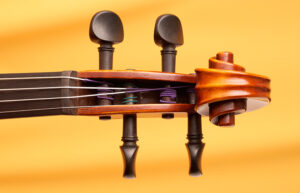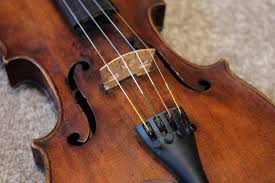How to Change Violin Strings
Having the ability to change strings is very important for all string players. Whether you are a violinist, violist, cellist, or bassist you can learn how to change strings in case a string breaks or you need to replace you strings. (Note: strings should be changed about every 6 months depending on how many hours a day you play). So, let’s learn how to change strings on your instrument.
1 – Remove the old string:
First we need to remove the old string. Simply loosen the peg for that string and gently pull the end of the string out of the peg hole.
Now the peg can come completely out of the peg box so be careful not to drop it. Remove the end of the string from the tail piece or fine-tuner. It is very important that you only remove one string at a time so that the bridge stays in place. To change all the strings on a violin, start with the A string and move down to D and G, changing the violin E string last since it is the smallest and most sensitive string. Use the same technique for Viola and Cello saving the A for last.
2 – Open the new string:
Open the package with the new string. Some strings are sold straight and some are coiled in the package. All strings have different colors at each end and the package should tell you which color is which string. Different brands of strings have different colors so make sure to check the packaging before you change strings. For example, with Tomastik Dominant Violin Strings the E 3/string is Purple, A string is Blue, D string is Green and G string is yellow at the tailpiece end of the strings and at the peg end all the strings are purple.
3 – Attach new string to the tail piece:
First place the ball end of the string in the hole on the tailpiece that corresponds with that string.
Some Violin E strings have loop ends to be placed on a fine tuner. If you have a fine tuner that needs a loop end but have an E string that has a ball end it is possible to gently remove the ball leaving the loop so that you can place it on the fine tuner. All tail pieces are different but have the same string holes so it is easy to change strings.
4 – Wrap the new string around the peg:
First, rotate the peg so that you can see the small hole where the string should go.
Stick the straight end of the string into the hole so that it goes all the way through but does not stick out too much on the other side of the peg or it will get caught on the peg box when rotating the peg. Next turn the peg away from you so that the string wraps around the peg. Try to wrap the string in the direction of the outside of the peg box so that when you are finished the string leads straight to the nut and doesn’t cross across the peg box. Also, try not to overlap the string when wrapping. If the string is the correct size for your instrument all strings should be the exact length to not need overlapping when winding on the peg. Only change strings that are the correct size for your instrument.
5 – Align the string in the bridge and nut
The bridge and the nut will have notches where the string should be. When you change strings do not tighten the string all the way until you check that the string is lined up properly with the notch in the nut and on the bridge.
For the violin E string it is recommended that you use the small rubber sleeve protector on the string to protect the bridge from getting a deeper grove from the sharp string. Simply slide this sleeve into position on the bridge. The excess part of the sleeve should be on the tailpiece side with hardly any hanging over the other side so that it does not dampen the sound.
6 – Tune the String:
Use a chromatic tuner as a guide to tighten the string to the right pitch. Be careful not to over tighten the string or it might break. If you change another string on the instrument you will have to re-tune this string. Also, brand new strings take a little while to hold tuning because they have to stretch. So after you change strings, it will be necessary to continuously re-tune the instrument until it holds its tuning. Usually this takes about one week after you change strings.
Need help tuning after you change strings? Schedule a lesson with Miss Laura!


Ready to pursue
your dream?
Schedule just 1 lesson, a few lessons or recurring lessons.
Join Online Violin Group Class.
